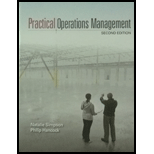
Concept explainers
A
Interpretation: Find out the productivity of both the companies and determine the company with higher productivity.
Concept Introduction: The production contribution of the total labor is represented by Labor Productivity.
A
Answer to Problem 22P
Through the calculations, we can infer that the productivity of the company A is 2.08 miles per hour, and that of the company B is 2.4 miles per hour. Hence, we can conclude that the Company B is higher productive of the two.
Explanation of Solution
Given Information: The ratio that relates output with the combined set of inputs involved is called as Multifactor Productivity.
Productivity of the companyA can be calculated using the below formula:
Thus, the productivity of the labor can be calculated as 17 poles per hour.
Productivity of the company B can be calculated using the below formula:
Thus, the productivity of the labor can be calculated as 2.4 miles per hour.
By observing the above derived results, we can see that the company B is more productive than the company A.
B
Interpretation: Find out the productivity of both the companies and determine the company with higher productivity, with the new assumptions.
Concept Introduction: The production contribution of the total labor is represented by Labor Productivity.
B
Answer to Problem 22P
Through the calculations, we can see that the labor productivity of the company A is more than that of the company B.
Explanation of Solution
Productivity of the labor can be calculated using the below formula:
Thus, the total labor cost is $5,760.
With the derived labor cost for company A, Multifactor productivity can be computed,
Now, we shall look at the labor productivity of the company B:
With the derived labor cost for company B, Multifactor productivity can be computed,
Thus, the company A is more productive than the company B.
C
Interpretation: Find out the productivity of both the companies and determine the company with higher productivity, with the new assumptions.
Concept Introduction: The production contribution of the total labor is represented by Labor Productivity.
C
Answer to Problem 22P
Through the calculations, we can see that the labor productivity of the company B is more than that of the company A.
Explanation of Solution
Productivity of the labor can be calculated using the below formula:
Thus, the total labor cost is $13,440.
With the derived labor cost for company A, Multifactor productivity can be computed,
Now, we shall look at the labor productivity of the company B:
With the derived labor cost for company B, Multifactor productivity can be computed,
Thus, the company B is more productive than the company A.
D
Interpretation: Provide a conclusion with regard to the differences in the productivity with the changes in the labor costs.
Concept Introduction: The production contribution of the total labor is represented by Labor Productivity.
D
Answer to Problem 22P
From the point of view of person X, the deriving differ.
Explanation of Solution
In spite of the productivity stays higher for company B, the equipment and material costs are higher. On the other hand, when the labor cost is $15 per hour, Company A is more productive. At a labor cost of $35 per hour, company B is more productive.
Want to see more full solutions like this?
Chapter 2 Solutions
Practical Operations Management
- Prepare a graph of the monthly forecasts and average forecast demand for Chicago Paint Corp., a manufacturer of specialized paint for artists. Compute the demand per day for each month (round your responses to one decimal place). Month B Production Days Demand Forecast Demand per Day January 21 950 February 19 1,150 March 21 1,150 April 20 1,250 May 23 1,200 June 22 1,000' July 20 1,350 August 21 1,250 September 21 1,050 October 21 1,050 November 21 December 225 950 19 850arrow_forwardThe president of Hill Enterprises, Terri Hill, projects the firm's aggregate demand requirements over the next 8 months as follows: 2,300 January 1,500 May February 1,700 June 2,100 March April 1,700 1,700 July August 1,900 1,500 Her operations manager is considering a new plan, which begins in January with 200 units of inventory on hand. Stockout cost of lost sales is $125 per unit. Inventory holding cost is $25 per unit per month. Ignore any idle-time costs. The plan is called plan C. Plan C: Keep a stable workforce by maintaining a constant production rate equal to the average gross requirements excluding initial inventory and allow varying inventory levels. Conduct your analysis for January through August. The average monthly demand requirement = units. (Enter your response as a whole number.) In order to arrive at the costs, first compute the ending inventory and stockout units for each month by filling in the table below (enter your responses as whole numbers). Ending E Period…arrow_forwardMention four early warning indicators that a business may be at risk.arrow_forward
- 1. Define risk management and explain its importance in a small business. 2. Describe three types of risks commonly faced by entrepreneurs. 3. Explain the purpose of a risk register. 4. List and briefly describe four risk response strategies. (5 marks) (6 marks) (4 marks) (8 marks) 5. Explain how social media can pose a risk to small businesses. (5 marks) 6. Identify and describe any four hazard-based risks. (8 marks) 7. Mention four early warning indicators that a business may be at risk. (4 marks)arrow_forwardState whether each of the following statements is TRUE or FALSE. 1. Risk management involves identifying, analysing, and mitigating risks. 2. Hazard risks include interest rate fluctuations. 3. Entrepreneurs should avoid all forms of risks. 4. SWOT analysis is a tool for risk identification. 5. Scenario building helps visualise risk responses. 6. Risk appetite defines how much risk an organisation is willing to accept. 7. Diversification is a risk reduction strategy. 8. A risk management framework must align with business goals. 9. Political risk is only relevant in unstable countries. 10. All risks can be eliminated through insurance.arrow_forward9. A hazard-based risk includes A. Political instability B. Ergonomic issues C. Market demand D. Taxation changesarrow_forward
 Purchasing and Supply Chain ManagementOperations ManagementISBN:9781285869681Author:Robert M. Monczka, Robert B. Handfield, Larry C. Giunipero, James L. PattersonPublisher:Cengage Learning
Purchasing and Supply Chain ManagementOperations ManagementISBN:9781285869681Author:Robert M. Monczka, Robert B. Handfield, Larry C. Giunipero, James L. PattersonPublisher:Cengage Learning Understanding Management (MindTap Course List)ManagementISBN:9781305502215Author:Richard L. Daft, Dorothy MarcicPublisher:Cengage Learning
Understanding Management (MindTap Course List)ManagementISBN:9781305502215Author:Richard L. Daft, Dorothy MarcicPublisher:Cengage Learning Practical Management ScienceOperations ManagementISBN:9781337406659Author:WINSTON, Wayne L.Publisher:Cengage,
Practical Management ScienceOperations ManagementISBN:9781337406659Author:WINSTON, Wayne L.Publisher:Cengage,




